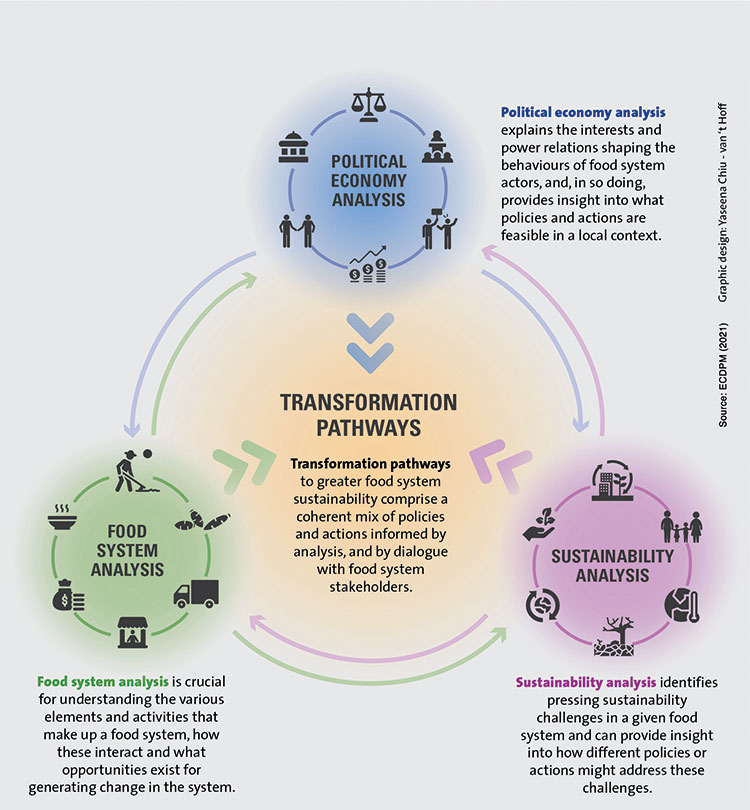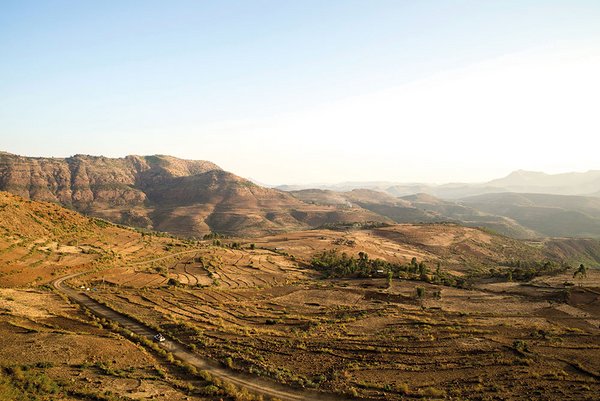 Download this article in magazine layout
Download this article in magazine layout
- Share this article
- Subscribe to our newsletter
Putting food systems analysis into practice – the example of Ethiopia’s Wag Himra Zone
Ensuring access to healthy diets throughout the year remains a challenge in large parts of Ethiopia. This also holds true for the Wag Himra Zone (WHZ) in Amhara Region in northern Ethiopia. Arid conditions have always prevailed there, with only 17 per cent of the land suitable for production. As a result of these and other factors, food insecurity is a developmental challenge for local populations and governments.
Helvetas Swiss Intercooperation has been implementing food and nutrition security projects in Ethiopia since the early 2000s. In the beginning of 2021, it started the second phase of its Climate Adaptation and Rural Development (CARD) project in WHZ. Here, the sustainable food systems approach developed by the European Centre for Development Policy Management (ECDPM) is employed in order to better understand challenges and opportunities of the local food system and to strengthen the systemic approach in CARD II. The aim is to test the relevance and usefulness of applying ECDPM’s sustainable food systems approach at zonal level. Based on the findings, it is planned to develop guidelines for food-system-sensitive project and intervention planning in zonal resilience programmes. At the time of writing, final results are not yet available. However, first insights are provided.
ECDPM’s food systems approach includes four components – a food system analysis, a sustainability analysis, a political economy analysis and the development of transformation pathways (see figure). Our analysis will highlight key aspects of these components, focusing particularly on the food system component. Here, different elements are highlighted, including the identification of food system boundaries and assessing key dynamics of activities, drivers, outcomes, events and trends. The boundary of the food system in question is the zonal boundary.
THE ECDPM SUSTAINABLE FOOD SYSTEMS APPROACH
Food systems cover all stakeholders, institutions and activities that play a role in production, processing, distribution, preparation and consumption of food items. All those activities contribute to positive and negative nutrition outcomes (e.g. malnutrition), trade-offs (e.g. degradation), as well as economic outcomes (e.g. income, employment). Various conditions (climate, power dynamics, mindsets) and human interventions (e.g. deforestation, innovation and migration) influence food systems and their outcomes.
Food system insights of Wag Himra Zone
Administratively, WHZ is divided into seven rural districts (woredas) and one town administration. The landscape is characterised by lowlands at around 1,000 metres and highlands with mountains around 4,000 metres tall. A vast, very rugged terrain of hills and gorges together with escarpments dominates the area. It is largely deforested, and bush scrubs, acacia trees and gum trees can be found. In the north, the Tekeze River is an important water system. The population density is low, and settlements are sparse.
Over 90 per cent of households throughout the WHZ live on smallholder farming with landholdings of less than one hectare. Most of the agricultural activities are rainfed and depend on the kremt rainy season (June to August), with the main harvest occurring from the end of September to November. Farmer households produce mainly cereals (sorghum, teff, barley, and wheat), pulses and vegetables. Significant cash crops include perennial crops, such as gesho or shiny leaf buckthorn (Rhamnus prinoides), or fruits, and in some parts also organic sesame for export. Livestock, like cattle (24 % of all livestock), equines (6 %), shoats (50 %) and chicken (20 %), but also bees, are kept for the consumption of their products, ploughing, sale (for cash income), and as savings mechanism to cope with economic shocks and stress.
The transport of the agricultural products and livestock to local markets is usually carried out by the producers themselves or by small local traders, on foot and with donkeys. A significant food processing industry does not exist in the zone. Marketing is usually done by men (except for chickens and eggs), giving them control over income and household decisions. Even when households are organised into cooperatives that operate like traders, women often find little entry into decision-making bodies. In addition to already participating in large parts of the agricultural work, women are burdened with being in charge of childcare, collecting water and firewood, cooking and other in-house activities.
Youth around the Tekeze Hydrodam reservoir started to engage in fishing in 2011, when the dam was constructed. Only seven per cent of the catch is consumed within the WHZ, with the remainder sold to urban centres outside the zone. Although fish is an excellent source of protein, less than a third of non-fishing households around the reservoir consume it. The reasons for this are negative perceptions of fish and the lack of a tradition to eat it.
Food system outcomes and drivers
The food system analysis revealed that households cover between 30 and 60 per cent of their food consumption through their own production and rely on buying additional staple foods. Poorer households do so early as April. This requires selling assets, such as livestock. Especially between June and September, people suffer food-deficient months. Overall, half of the households in WHZ are assumed to be food-insufficient. In this regard, female-headed households appear to be the most vulnerable group. COVID-19 restrictions have further limited some additional income sources, such as labour migration. Support through the government’s Productive Safety Net Programme (PSNP) and emergency programmes is essential for up to 50 per cent of all households in WHZ.
Overgrazing and excessive firewood collection are major factors for deforestation. Because of vegetation being thus decimated, critical ecosystem services such as the maintenance of soil health, fixing nutrients, providing protection and preventing soil degradation are lost. Combined with consequences of climate change, like low and erratic rainfall patterns, the food system’s capacity of providing decent livelihoods is critically restrained. WHZ is already considered the most drought-prone area in Amhara Region. Innovations such as early maturing pearl millet varieties and home orchard development (already part of CARD I) are being introduced mainly through externally funded projects and in collaboration with Ethiopia's Sekota Dryland Agricultural Research Centre. However, the widespread adoption of such innovations within the zone often turns out to be hampered. The reasons for this will be explored in the in-depth analysis.
The recent influx of larger groups of internally displaced persons and returnees from various conflict-prone regions of the country is exacerbating pressure on food supplies and land availability, creating the risk of distributional conflicts.
Sketching sustainability issues and the political economy
The ecosystem’s reduced carrying capacity under current management systems challenges the economic viability of farming communities and the food system’s longevity. The way agriculture is still primarily practised in WHZ does not ensure sustainable management of natural resources and does not provide the opportunity to build savings to absorb frequent livelihood shocks. Market failures such as information asymmetries and impeded market access further inhibit the economic sustainability of the food system and disadvantage producers in particular.
Strengthening the local food and nutrition security enjoys a remarkably good status in the governmental political development agenda. Policy components such as de-stocking of livestock, zero or controlled grazing and strengthening agricultural cooperatives and community watershed institutions are among those widely supported. However, practical implementation still lags behind the theoretical claims in terms of effectiveness.
Local governments at the regional and local levels carry the political and economic agenda down to the lowest administrative level (kebeles) through an elaborate extension service system via development agents. Through joint efforts, community institutions such as kebele development committees or watershed committees were strengthened for the people’s political empowerment. However, women don’t enjoy significant participation and influence on actions and decisions.
Potential transformation pathways
As shown above, major food system-related challenges are access to water, weak value chains and limited consumer nutrition awareness. Access to water can be increased through introduction of new technologies and landscape management. For instance, ring-basin infiltration pits (already promoted in CARD I) and area closure allow the vegetation to recover, enhance water infiltration, reduce erosion and improve soil fertility. This lowers dependency on scarce water resources, the costs of water extraction as well as associated risks. Depending on the method, infrastructure construction and maintenance can provide employment opportunities for youth. This development can be catalysed by interventions such as transferring knowledge and technology through the government’s extension system. Furthermore, by strengthening the governance capacity of community-based organisations, they are able to develop strong bylaws. This will ensure an effective management and control of implemented measures such as area closures.
Another pathway focuses on transforming existing and facilitating new value chains that generate positive livelihood outcomes. There are ongoing efforts in agricultural production to introduce climate-smart practices including early maturing, drought-tolerant and market-oriented crops like pearl millet, mung bean and lentils. In addition, multipurpose crops like pigeon pea serve as livestock forage and food, and contribute to soil conservation (part of CARD II). Honey value chains also have potential for improvement. Strengthening multi-purpose cooperatives is an entry point to accelerate dissemination of the above-mentioned improved crops and improve access to markets and input supplies. Furthermore, the reinforcement of local credit and savings mechanisms ensures access to finance for smallholders for investing into these value chains and to adapt agricultural production systems.
Also, increasing consumer awareness of the nutritional value of, for example, fish and vegetables through cooperative-led information campaigns can contribute to further systemic transformation. Therefore, trainings on business skills, nutrition and communication for cooperatives through the government extension system should be considered. In addition, public schemes such as the PSNP provide an entry point to distribute nutrition-sensitive messages and to enhance the knowledge of consumers.
Next steps
In the coming months, the detailed food system analysis will be further deepened, and simplified guidelines for its replication will be developed. Although Helvetas’ interventions aim for change at the system level to improve livelihoods and food security, they lack a common food systems perspective. The ECDPM approach creates a process framework for project staff, local researchers and local government partners to better identify interlinkages between parts of the food system and recognise interventions in their systemic embeddedness. The in-depth testing of the approach will also show how the approach can identify root causes of food system challenges and mobilise system actors to plan strategic interventions at scale. Strengthening approaches, tools and guidelines for effective and efficient application of the food systems approach can only be achieved jointly. Therefore, Helvetas looks forward to discussing the concrete results expected in 2022 with interested parties.
Patrik Aus der Au is Junior Professional at Helvetas Swiss Intercooperation (HSI) in Ethiopia.
Gebrat Kidie is Project Manager of CARD at HSI in Ethiopia.
David Bexte is Advisor at HSI in Switzerland.
Contact: david.bexte@helvetas.org
Further reading:
ECDPM guidelines on Sustainable Food Systems Approach
ECDPM brochure on the Sustainable Food Systems Approach





Add a comment
Comments :
<a href="https://www.knowledge-wisdom.com/what-does-a-business-system-analyst-do/">business system analyst</a>